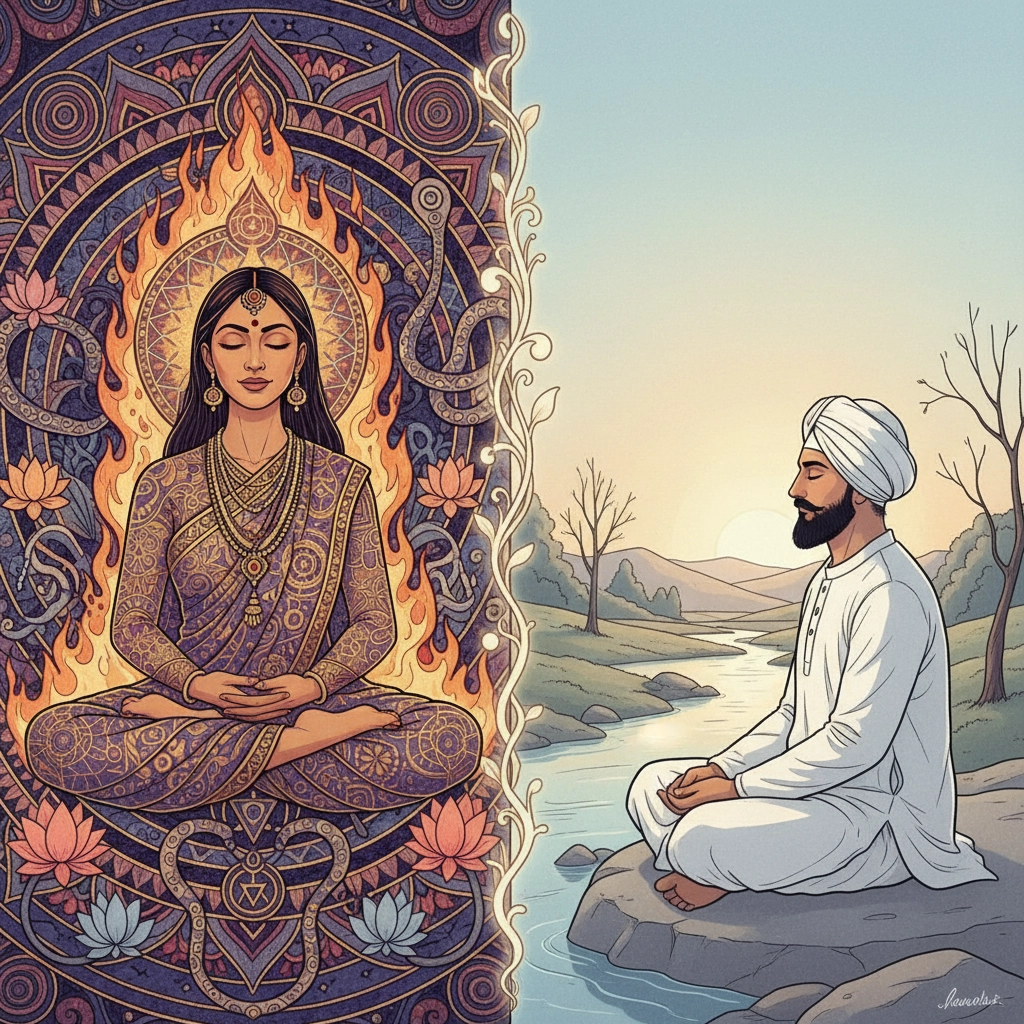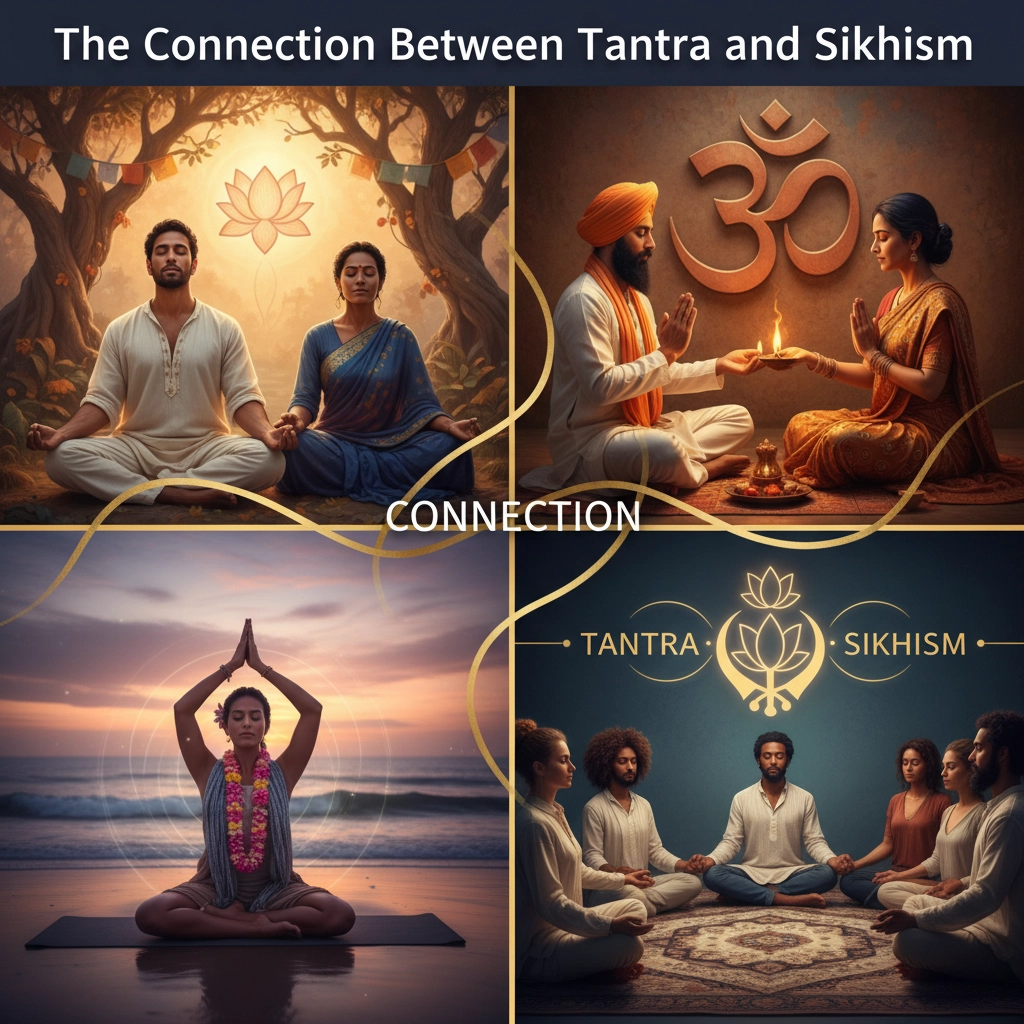When exploring the spiritual landscape of India, it's natural to wonder how different traditions might intersect or influence each other. The relationship between Tantra and Sikhism presents a particularly complex case study: one that requires careful examination to separate historical fact from modern misconceptions.
While both traditions emerged from the Indian subcontinent and share certain broad spiritual concerns like meditation and inner transformation, their relationship is far more nuanced than many realize. In fact, traditional Sikhism explicitly rejects tantric practices, viewing them as fundamentally incompatible with Sikh teachings. Understanding this dynamic offers valuable insights into how spiritual traditions define themselves not just by what they embrace, but by what they consciously reject.
Historical Origins and Timeline
Tantra developed as an esoteric yogic tradition beginning around the middle of the 1st millennium CE, initially within Shaivism. This tradition underwent significant transformation between the fifth and eighth centuries, incorporating fierce deities: particularly powerful female goddesses: and developing elaborate ritualistic practices that often deliberately transgressed social norms.
Sikhism emerged much later, founded by Guru Nanak (1469-1539) in the Punjab region. The faith developed through ten successive Gurus over approximately 200 years, culminating with Guru Gobind Singh in the early 18th century. This timeline places Sikhism's origins nearly a millennium after Tantra's initial development, making Sikhism the younger tradition by a significant margin.

Surface-Level Similarities: Where Confusion Begins
At first glance, certain elements might suggest connections between these traditions. Both acknowledge the importance of meditation and inner spiritual experience. Both recognize concepts related to spiritual energy: though they approach and understand these concepts very differently.
Meditation and Inner Experience
Sikhism places enormous emphasis on meditation, particularly through simran (remembrance of the divine name) and dhyan (focused contemplation). This meditative focus might seem to align with tantric practices, which also emphasize inner transformation through various techniques.
However, the methods and goals differ substantially. Sikh meditation centers on devotion to one formless God (Waheguru) and the repetition of divine names, while tantric meditation often involves complex visualizations, mantras directed toward specific deities, and energy manipulation techniques.
Energy and Spiritual Power
Both traditions acknowledge that spiritual practice can awaken inner energies. Tantric traditions speak extensively about kundalini energy and chakras, while Sikh spirituality recognizes the power of divine connection to transform consciousness.
Yet here too, the approaches diverge significantly. Tantra often seeks to harness and direct these energies through specific techniques, sometimes including elaborate rituals or visualizations. Sikhism, by contrast, emphasizes surrender to divine will rather than personal manipulation of spiritual forces.
The Fundamental Divide: Sikh Critique of Tantric Practices
Understanding the Sikh position on Tantra requires examining explicit teachings from Sikh Gurus themselves. Far from embracing tantric practices, traditional Sikhism views them as obstacles to authentic spiritual development.
Guru Gobind Singh's Demonstration
One of the most telling historical accounts involves Guru Gobind Singh, the tenth Sikh Guru, who directly addressed tantric practices. According to historical records, the Guru allowed a Brahman named Kesho Das to perform tantric experiments, ultimately demonstrating "the futility of tantra and other such cults." This wasn't merely theoretical criticism: it was a practical demonstration of why these practices didn't align with Sikh spiritual goals.
Scriptural Position
The Sikh scriptures explicitly reprove tantric practices. This isn't a matter of interpretation or scholarly debate: it's clearly stated within the foundational texts of Sikhism. The tradition consistently emphasizes devotion, ethical living, and service over the ritualistic and esoteric approaches characteristic of Tantra.

Philosophical Incompatibilities
The deeper we examine these traditions, the more their fundamental incompatibilities become apparent.
Approach to the Divine
Sikhism is strictly monotheistic, emphasizing devotion to one formless, eternal God. Tantric traditions, particularly in their classical forms, often involve worship of multiple deities, elaborate pantheons, and complex ritualistic approaches to accessing divine power.
Role of Ritual and Practice
While Sikhism includes certain rituals and practices, it emphasizes simplicity and direct connection with the divine. Tantra, by definition, involves intricate techniques, complex visualizations, and often esoteric knowledge passed through specific lineages.
Social and Ethical Frameworks
Sikhism emphasizes equality, service, and ethical living within society. Classical Tantra, particularly in its more esoteric forms, sometimes included deliberately transgressive practices that violated social norms: an approach fundamentally at odds with Sikh emphasis on righteous living.
The Yogi Bhajan Controversy: Modern Misconceptions
Much contemporary confusion about the relationship between Tantra and Sikhism stems from the controversial teachings of Yogi Bhajan, who arrived in the United States in the 1960s promoting what he called "Tantric Yoga Sikhism."
Bhajan's Own Admission
In recorded conversations with Dr. Trilochan Singh, Yogi Bhajan frankly acknowledged that "Tantra (White as he calls it) is his basic faith while Sikhism is only an off-shoot of his Tantric system." This admission reveals that his approach prioritized tantric practices over authentic Sikh teachings.
Mainstream Sikh Rejection
Sikh scholars and practitioners have consistently rejected Bhajan's synthesis as inauthentic. They describe his teachings as a "crude mixture of Sikhism and Tantric Yoga" that contradicts the fundamental principles of Sikh spirituality. This rejection isn't based on rigid orthodoxy but on careful examination of how these combined teachings diverge from established Sikh doctrine and practice.
Creating False Connections
Bhajan's movement created various hybrid practices and concepts, such as "Tantric Necklaces" claimed to provide "healing, comforting, and elevating energy of White Tantra Yoga." These innovations have no basis in traditional Sikh practice and represent modern inventions rather than historical connections.

Why the Distinction Matters
Understanding the actual relationship: or lack thereof: between Tantra and Sikhism serves several important purposes for sincere spiritual seekers.
Respecting Authentic Traditions
Both Tantra and Sikhism deserve to be understood on their own terms rather than through synthetic modern interpretations. Each tradition has its own integrity, wisdom, and proper methods of practice.
Avoiding Spiritual Confusion
Mixing incompatible approaches can create confusion rather than clarity in spiritual practice. Someone drawn to Sikh spirituality benefits from understanding its actual methods and goals rather than hybrid alternatives.
Historical Accuracy
Accurate understanding of how spiritual traditions developed helps us appreciate the specific conditions and insights that gave rise to different approaches to the divine.
Moving Forward with Clear Understanding
For those interested in either tradition, the key lies in approaching each with respect for its authentic teachings and practices. Sikhism offers a complete spiritual path emphasizing devotion, service, and ethical living. Tantra provides its own complex system of practices and understanding.
Rather than seeking artificial connections, practitioners benefit more from choosing a path that genuinely resonates with their spiritual inclinations and committing to authentic practice within that tradition. The diversity of spiritual approaches reflects the richness of human spiritual seeking: not every tradition needs to be connected to every other tradition to be valid and valuable.
The relationship between Tantra and Sikhism ultimately illustrates how spiritual traditions sometimes define themselves through conscious rejection of other approaches, creating distinct paths for different temperaments and spiritual goals. Understanding this helps us appreciate both the unity and diversity within India's rich spiritual heritage.



